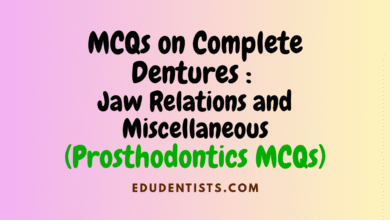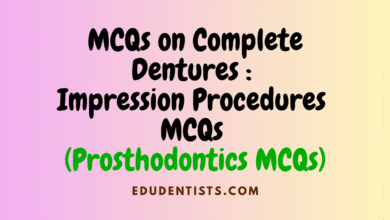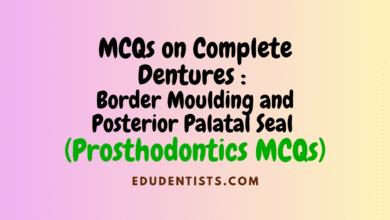Prosthodontics MCQs
Removable Prosthodontics Questions _ Removable Dentures MCQs _ Dental MCQs

Removable Prosthodontics Questions _ Removable Dentures MCQs _ Dental MCQs
- The patient is asked to close the mouth forcefully while dentist apply pressure on lower anterior to record:
A. Buccal shelf
B. Retromylohyoid fossa
C. Masseteric notch
D. Lingual border - All of the following are mechanical methods to determine vertical dimension except:
A. Pre-extraction records
B. Ridge relation
C. Phonetics
D. Measurement from former denture - Fischer’s angle is formed by the intersection of the protrusive and non-working side condylar paths as viewed in the _______ plane:
A. Horizontal
B. Reverse
C. Sagittal
D. Oblique - Bennett angle is formed between the sagittal plane and the average path of the advancing condyle as viewed in a horizontal plane during:
A. Medial movement
B. Lateral movement
C. Centric freedom Inter-cuspal
D. Movement - Which of the following measures the vertical dimension when the mandible and muscles involved are in physiologic function of speech?
A. Freeway space
B. Leeway space
C. Closest speaking space
D. Primate space - Retromylohyoid curtain is not formed by:
A. Superior constrictor
B. Palatoglossal muscle
C. Mylohyoid
D. Masseter - The inner vermilion border of the lower lip traps air against the inner edges of maxillary incisors during the pronunciation which of the following letter?
A. C
B. F
C. Z
D. S - The condylar guidance of an articulator is dependent on the:
A. Depth of the glenoid fossa
B. Vertical overlap of the incisors
C. Cuspal inclines
D. Inclination of the articular eminence - The anteroposterior curve is:
A. Curve of Spee
B. Curve of Wilson
C. Curve of Monson
D. Bonwill curve - Which is the constituent of the gypsum-bonded investment that acts as a binder?
A. Quartz
B. Silica
C. Graphite
D. Calcium sulfate hemihydrate - Which of the following rule explains about the grinding of certain cusps to produce balance in lateral movements?
A. Ante’s law
B. Bull rule
C. Wolf’s rule
D. Cieszynski rule - Classification by Leon Williams gives an idea about
A. Number of teeth and size of the arch
B. Residual alveolar ridge
C. The form of tooth and face
D. Colour of artificial teeth - In Bonwill equilateral triangle the apex of the triangle is located at:
A. The anterior part of incisive papilla
B. The prominent part of chin upper central
C. The anteriormost part of incisor
D. The anteriormost part of the lower central incisor - Discrepancies in the occlusion of a denture can be clearly detected from:
A. Observation of the denture in the mouth
B. Masticatory efficiency
C. Clicking sounds at Temporomandibular joint
D. Remounting procedures of the denture - Bilateral balanced occlusion is the balance in the:
A. Working lateral and protrusive contact
B. Lateral contacts only
C. Working, balancing and protrusive contact
D. Protrusive contacts only - One of the following is the characteristic of an “Arcon” articulator:
A. The condylar elements are placed on the upper member of the articulator
B. The condylar elements are placed on the lower member of the articulator
C. The condylar elements are non-movable
D. The inclination of the condylar path is in a curved plane - The ratio of the width of the central incisor and the bizygomatic width is:
A. 1:13
B. 1:14
C. 1:15
D. 1:16 - Articulators:
A. Duplicate jaw movements
B. Simulate jaw movements
C. Have condylar movements
D. Reproduce the Bennett movement - Selective grinding for equilibrating complete dentures is best accomplished after processing when the dentures are:
A. Rearticulated using original jaw relation record
B. Rearticulated with a new series of jaw relation
C. Equilibrated in the patient’s mouth
D. Spot ground in the patient’s mouth - Resorption of the mandible in old age is usually:
A. Centrifugal
B. Centripetal
C. Centrifugal anteriorly & centripetal posteriorly
D. Centrifugal posteriorly & centripetal anteriorly - It is called as a repeated or sustained contact of teeth other than during mastication:
A. Malfunction
B. Parafunction
C. Hyperfunction
D. Hypofunction - If a patient with complete denture complains of pain while swallowing due to the overextension of denture in the distolingual aspect. The muscle involved is:
A. Superior constrictor
B. Palatopharyngeus
C. Palatoglossus
D. Stylopharyngeus - Use of overextended complete denture for a prolonged period without adjustment may cause:
A. Epulisfissuratum
B. Pyogenic granuloma
C. Papillary hyperplasia
D. Giant cell reparative granuloma - Placing a ring liner approximately 3.25 mm short of the end of the ring tends to produce:
A. More uniform expansion and the expansion is not in a vertical direction hence no distortion
B. More uniform contraction
C. No change
D. Distortion - In the construction of immediate denture, anterior teeth are extracted:
A. In the first appointment
B. Before construction of denture
C. After denture construction
D. After posterior teeth - One of the following is not the advantages of overdenture?
A. Preservation of alveolar bone
B. Aesthetics
C. Retention
D. Support - Which should be treated by using a tissue conditioner material:
A. Tissue symptoms related to diabetes mellitus
B. Generalized ridge hyperplasia
C. Traumatized mucosa caused by ill-fitting dentures
D. The sharp residual ridge in the molar area - The most important reason for retaining healthy roots and prescribing an overdenture rather than extractions and a conventional complete denture is:
A. To preserve the alveolar bone
B. An overdenture is easier to construct rather than a complete denture
C. The apparent ease with which the patient adapts to an overdenture
D. To retain some degree of proprioception from the healthy periodontal ligament of the roots - Which of the following is the main disadvantage of single complete denture against natural teeth?
A. Abrasion of artificial teeth
B. Difficulty in the making of balanced occlusion
C. Abrasion of natural teeth
D. All of the above - Ear prosthesis is made from which of the following?
A. Methyl methacrylate
B. Metallic implants
C. Silicone
D. Epoxy resin - GLOMUS cell arteriovenous shunting system to occupy and empty condylar space as required is called:
A. Vascular knee
B. Modiolus
C. Anastomosis
D. Condylar shunt - Opening and closing of the mandible without applying the pressure suring bilateral manipulation of mandible in to centric relation is called:
A. Directing the mandible
B. Rotating the mandible
C. Romancing the mandible
D. None of the above - The zone of neutrality between outward pressure from tongue and inward pressure from buccinator- orbicularis oris band of muscle is:
A. Positive zone
B. Neutral zone
C. Zone of equality
D. Reduction zone - Long centric refers to:
A. Freedom to close the mandible either in to cenric relation or slightly posterior to it without varying the vertical dimention at the anterior teeth
B. Freedom to close the mandible either in to cenric relation or slightly posterior to it with increased vertical dimention at the anterior teeth
C. Freedom to close the mandible either in to cenric relation or slightly posterior to it with decreased vertical dimention at the anterior teeth
D. Freedom to close the mandible either in to cenric relation or slightly anteriorr to it without varying the vertical dimention at the anterior teeth - Outer limits of movements to which mandible can move is called:
A. Envelope of function
B. Envelope of laterotrusion
C. Envelope of motion
D. None of the above - During speech:
A. Lower teeth are more visible than upper teeth
B. Upper teeth are more visible than lower teeth
C. Both upper and lower teeth are equally visible
D. Neither upper nor lower teeth are visible. - In normal smile line which of the following in not true:
A. Lower teeth are covered by lower lip
B. Lower lip relates to the incisal edges of the upper teeth
C. Incisal edges of the lower teeth are parallel to upper lip
D. Lower lip is parallel to incisal edges of upper teeth - Pankey-mann-schuyler technique uses _______ to determine the occlusal plane.
A. Mansoon occlusal plane analyser
B. Broadric occlusal plane analyser
C. Wilson occlusal plane analyser
D. Anterior occlusal plane analyser - In pankey-mann-schuyler technique which of the following technique is used for developing maxillary posterior occlusion:
A. Bilaterl balanced occlusion technique
B. Monoplane occlusal technique
C. Functionally generated path technique
D. Neutrocentric occlusal technique.





